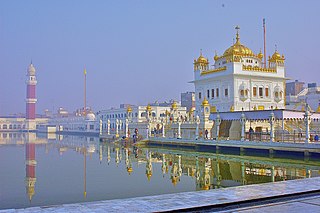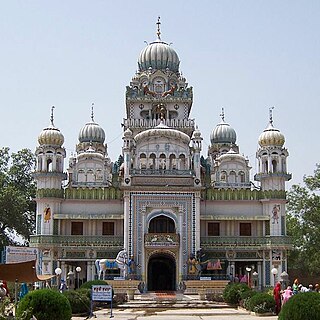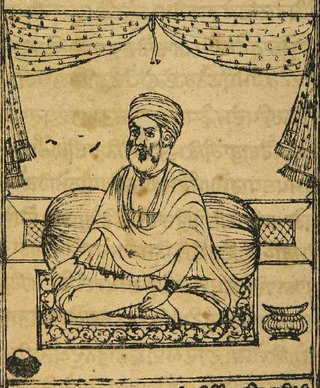The following outline is provides an overview of Sikhism, or Sikhi.

The Damdamī Ṭaksāl, Jatha Bhindra(n), or Sampardai Bhindra(n) is an orthodox Khalsa Sikh cultural and educational organization, based in India. They are known for their teachings of vidya as well as gurbanisanthiya. Its headquarters are located in the town of Mehta Chowk, approximately 40 km north of the city of Amritsar. It has been described as a seminary or “moving university” of the Sikh countryside.

Tarn Taran Sahib is a city in the Majha region of the state of Punjab, in northern India. It is the district headquarters and hosts the municipal council of Tarn Taran district. Gurdwara Sri Tarn Taran Sahib, a prominent Sikh shrine, is located in the central part of the city.
The Akhand Kirtani Jatha, alternatively romanized as the Akhand Keertanee Jathaa and abbreviated as AKJ, is a jatha and sect of Sikhism dedicated to the Sikh lifestyle. The Jatha follows a strict discipline in keeping the Rehat of Guru Gobind Singh. They also enjoy an active style of Keertan recited by Sikhs in a collective manner in front of Guru Granth Sahib. This style of Keertan is relatively simple, and the entire congregation devotionally participates in singing along.

Anandpur Sahib, also referred simply as Anandpur, is a city in Rupnagar district (Ropar), on the edge of Shivalik Hills, in the Indian state of Punjab. Located near the Sutlej River, the city is one of the most sacred religious places in Sikhism, being the place where the last two Sikh Gurus, Guru Tegh Bahadur and Guru Gobind Singh, lived. It is also the place where Guru Gobind Singh founded the Khalsa Panth in 1699. The city is home to Takhat Sri Kesgarh Sahib, the third of the five Takhts in Sikhism.

The Takht Sri Darbar Sahib Damdama Sahib, is one of the five takhts or Seat of Temporal Authority of Sikhism, located in Talwandi Sabo, near the city of Bathinda in Bathinda district of Punjab, India. At this place Guru Gobind Singh, the tenth Sikh Guru, prepared the full version of the Sikh scriptures called Sri Guru Granth Sahib in 1705. The other four Takhts are the Akal Takht, Takht Sri Keshgarh Sahib, Takht Sri Patna Sahib and Takht Sri Hazur Sahib.

Talwandi Sabo is a town and Municipal Council, in Bathinda District, Punjab, India. It is famous for being the town in which one of the five Takhts of Sikhism where Takht Sri Damdama Sahib. It is also famous for its Baisakhi, which is celebrated on the 13th of April every year. It is a major cultural, transportation and agricultural centre, located in the Malwa region of Punjab. It is near the Punjab-Haryana border.

Sikh music, also known as Gurbani Sangeet , and as Gurmat Sangeet, or even as Shabad Kirtan, is the classical music style that is practised within Sikhism. It exists in institutional, popular, and folk traditions, forms, and varieties. Three types of Sikh musicians are rababis, ragis, and dhadhis. Sikh music exists in various melodic modes, musical forms, styles, musicians, and performance contexts.

The principal Sikh scripture is the Adi Granth, more commonly called the Guru Granth Sahib. The second most important scripture of the Sikhs is the Dasam Granth. Both of these consist of text which was written or authorised by the Sikh Gurus.

Gurdwara Sis Ganj Sahib is one of the nine historical Gurdwaras in Delhi. It was first constructed in 1783 as a small shrine by Baghel Singh to commemorate the martyrdom site of the ninth Sikh Guru, Tegh Bahadur and was probably expanded after Indian Rebellion of 1857 or after Partition of India. Before its construction the Mughal Kotwali was situated here. After the Indian Rebellion of 1857 the Mughal Kotwali was demolished by the British and the land was given to the Sikhs as the maharaja of Patiala and other Sikh soldiers helped the British to defeat the Mughal soldiers by providing large numbers of ammunition and soldiers. Its current building was made by Rai Bahadur Narain Singh a contractor who build most of roads in Lutyens New Delhi construction under British Rule. Situated in Chandni Chowk in Old Delhi, it marks the site where the ninth Sikh Guru was beheaded on the orders of the Mughal emperor Aurangzeb on 11 November 1675. The Sikh regiment of the Indian army salute the Sis Ganj Gurudwara before saluting the president of India since 1979, the only instance of saluting twice in the Republic Day parade by a regiment of Indian army.
Akhand Path The continuous and uninterrupted recitation of Sri Guru Granth Sahib Ji is known as Akhand Path Sahib.

Baba Deep Singh is revered among Sikhs as one of the most hallowed martyrs in Sikhism. He is remembered for his sacrifice and devotion to the teachings of the Sikh Gurus. Baba Deep Singh was the first head of Misl Shaheedan Tarna Dal – an order of the Khalsa military established by Nawab Kapur Singh, the then head of Sharomani Panth Akali Buddha Dal. The Damdami Taksal also state that he was the first head of their order.

Gurdwara Mehdiana Sahib, also called the 'School of Sikh History' is a Sikh gurdwara located in the village of Mehdiana, just outside Mallha, near Jagraon in Ludhiana district, India.

Hazur Sahib, also known as Takht Sachkhand Sri Hazur Abchalnagar Sahib, is one of the five takhts in Sikhism. The gurdwara was built between 1832 and 1837 by Maharaja Ranjit Singh (1780–1839). It is located on the banks of the Godavari River at the city of Nanded in the state of Maharashtra, India.

A Ragi is a Sikh musician who plays hymns (shabads) in different ragas as prescribed in the Sri Guru Granth Sahib.

Pandit Tara Singh Narotam (1822–1891) or also Pundit Tara Singh Nawtam, was a famous Punjabi scholar who belonged to the Sikh Nirmala Sect.

The 1978 Sikh–Nirankari clash occurred between the Sant Nirankari Mission and Sikhs of Damdami Taksal and Akhand Kirtani Jatha on 13 April 1978 at Amritsar, Punjab, India. Sixteen people—thirteen traditional Sikhs and three Nirankari followers—were killed in the ensuing violence, occurring when some Akhand Kirtani Jatha and Damdami Taksal members led by Fauja Singh protested against and tried to stop a convention of Sant Nirankari Mission followers. This incident is considered to be a starting point in the events leading to Operation Blue Star and the 1980s Insurgency in Punjab.

Sikh sects, denominations, traditions, movements, sub-traditions, also known as sampardai in the Punjabi language, are sub-traditions within Sikhism that believe in different approaches to practicing the religion. All sampradas believe in the One Creator God typically rejecting both idol worship and caste systems. Different interpretations have emerged over time, some of which have a living teacher as the leader. The major historic traditions in Sikhism, says Professor Harjot Oberoi, have included Udasi, Nirmala, Nanakpanthi, Khalsa, Sahajdhari, Namdhari Kuka, Nirankari and Sarvaria.
















